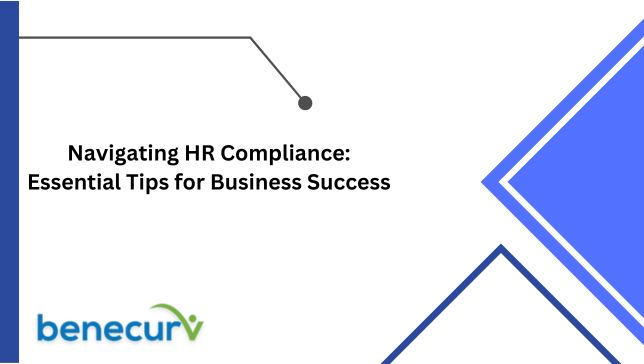Navigating HR Compliance: Essential Tips for Business Success

Strong 8k brings an ultra-HD IPTV experience to your living room and your pocket.
In today's complex business environment, adhering to HR compliance is more crucial than ever. It ensures a fair and legal workplace for employees and protects businesses from costly legal issues and reputational damage.
This comprehensive guide empowers businesses of all sizes to navigate HR compliance effectively. We'll delve into essential areas, offer practical tips, and answer frequently asked questions to equip you with the knowledge and resources needed to build a compliant and successful workplace.
Essential Tips for Business Success
1. Understanding HR Compliance:
HR compliance encompasses adhering to federal, state, and local laws and regulations governing employment practices. These regulations cover various aspects of the employee lifecycle, including:
- Recruitment and selection
- Compensation and benefits
- Training and development
- Workplace safety and health
- Performance management
- Termination of employment
2. Why is HR Compliance Important?
There are compelling reasons for businesses to prioritize HR compliance:
- Minimizes legal risks: Non-compliance can lead to costly lawsuits, fines, penalties, and government sanctions.
- Protects your employees: Ensuring a safe, fair, and legal work environment is vital for employee morale and well-being.
- Boosts reputation: A reputation for ethical and compliant practices can attract and retain top talent.
- Improves employee relations: Fostering a culture of fairness and respect strengthens employee engagement and productivity.
- Promotes business growth: A stable and compliant work environment allows businesses to focus on growth and innovation.
Essential Tips for Navigating HR Compliance:
1. Develop a Culture of Compliance:
Foster an organizational culture that prioritizes ethical behavior and adherence to regulations. Make compliance a core value and communicate its importance to all employees. Train managers and supervisors on key HR compliance issues.
2. Stay Updated on Changing Laws:
Regularly review and update your understanding of relevant federal, state, and local employment laws. Subscribe to reliable HR compliance resources or engage with legal counsel to stay informed of changes.
3. Implement Clear and Comprehensive Policies:
Develop and maintain written policies on key HR topics, such as anti-discrimination, harassment prevention, and workplace safety. Ensure policies are easily accessible to all employees and translated if necessary.
Regularly review and update policies to reflect any changes in regulations.
4. Establish a Complaint Resolution Process:
Create a clear and accessible process for employees to report potential violations of HR policies or illegal behavior. Ensure complaints are investigated thoroughly, fairly, and confidentially. Provide training on the complaint process to employees and managers.
5. Conduct Regular Training and Communication:
Provide ongoing training to employees and managers on their rights and responsibilities under HR policies and relevant laws. Utilize various communication channels (e.g., employee handbooks, online training modules) to regularly educate employees.
Encourage open communication and address any questions or concerns promptly.
6. Utilize Technology and Resources:
Consider using HR software solutions or online resources to manage compliance tasks and stay updated on changes. Seek guidance from legal counsel or HR professionals when facing complex compliance issues.
7. Conduct Self-Audits:
Regularly conduct internal audits to identify and address any potential compliance gaps. Consider engaging external auditors for a more comprehensive review.
Specific Examples of HR Compliance Best Practices:
1. Recruitment and Selection:
Develop a job description that is free of discriminatory language and accurately reflects the job requirements. Utilize diverse recruitment strategies to attract a wider pool of qualified candidates.
Implement a structured interview process with standardized questions for all applicants.
2. Compensation and Benefits:
Ensure accurate and timely payment of wages and benefits as required by law. Offer competitive compensation and benefits packages to attract and retain top talent.
Clearly communicate benefits policies and eligibility requirements to employees.
3. Training and Development:
Provide ongoing training on anti-discrimination, harassment prevention, and other relevant topics. Invest in employee development opportunities to enhance their skills and knowledge.
Create a culture of learning and continuous improvement within the organization.
4. Workplace Safety and Health:
Implement and maintain a comprehensive safety program to protect employees from workplace hazards. Regularly inspect workplaces to identify and address potential safety risks.
Provide appropriate personal protective equipment (PPE) to employees as needed.
5. Performance Management:
Establish clear and objective performance standards for all employees. Conduct regular performance reviews to provide feedback and support employee growth.
Implement a fair and consistent discipline process when necessary.
6. Termination of Employment:
Follow all legal requirements regarding termination, including providing proper notice and severance pay (if applicable). Maintain accurate personnel records and separation documents.
Conduct exit interviews to gather feedback and improve future practices.
Conclusion:
By utilizing these additional resources and implementing the best practices mentioned above, businesses can demonstrate a proactive approach to HR compliance, fostering a fair and legal work environment for employees and building a foundation for sustainable business success.
FAQs:
Q: What are the most common HR compliance violations?
A: Common violations include wage and hour issues, discrimination and harassment, improper classification of employees (exempt/non-exempt), and inadequate recordkeeping.
Q: Who is responsible for ensuring HR compliance in a business?
A: While leadership holds ultimate responsibility, compliance is typically a shared responsibility involving HR professionals, managers, and all employees.
Q: What happens if a business is found to be non-compliant?
A: The consequences can vary from fines and penalties to lawsuits and government investigations, depending on the nature and severity of the violation.
Remember: Navigating HR compliance may seem complex, but it doesn't have to be overwhelming. By adopting these essential tips, building a culture of compliance, and seeking professional guidance when needed, you can ensure a legal, ethical, and successful workplace for your business and employees.
Note: IndiBlogHub features both user-submitted and editorial content. We do not verify third-party contributions. Read our Disclaimer and Privacy Policyfor details.







